Rising school absence: what do we know and what can we do?
By Blog Editor, IOE Digital, on 16 January 2024

Credit: Smolaw11 / Adobe.
16 January 2024
By Lindsey Macmillan and Jake Anders
The start of 2024 has seen a renewed focus on persistent absenteeism from school, with the Secretary of State for Education announcing a major national drive to improve school attendance, and the Shadow Secretary of State for Education laying out Labour’s plans to ‘rebuild the broken relationship between schools, families and the Government’. Yet this is not a new problem: the issue of persistent absenteeism has been looming since schools returned to ‘normal’ after the COVID-19 pandemic.
Everyone agrees that the rise in pupil absence since the pandemic is of significant concern. But the causes and what we should do about this are much less clear.
In particular, it is striking how challenging it is to get a clear picture of parents’ perceptions of the problem. Research by Public First highlights that many parents are unconvinced by the “every day matters” approach to absence, yet 88% endorse this message in YouGov’s polling for the Centre for Social Justice. While this does leave 8% disagreeing with the statement (and a further 4% not expressing a view either way), which is still a large number of parents, it seems implausible that this alone could explain the majority of the increase in absence rates.
The reality of the situation is that the substantial rise is likely due to a ‘perfect storm’ of combining factors exacerbated by the aftermath of the pandemic. It will take a multifaceted response over several years to turn the situation around. Below, we unpick some of the patterns in absence, highlighting parental attitudes but also cost of living, special educational needs, and mental health as some of the headline factors in this ‘perfect storm’. The fact that these latter factors are predictive of persistent absenteeism when comparing similar pupils (in terms of background and prior attainment) highlights their importance, too, to determining effective policy responses.
Post-COVID trends in absenteeism
As Figure 1 illustrates, total rates of persistent absenteeism, defined as a student missing 10% or more of sessions, jumped from 8.4% to 18.2% in primary schools, and 12.7% to 26.7% in secondary schools between 2018/19 and 2021/22, and the latest available annual data from 2022/23 suggests they show no sign of returning to pre-pandemic levels. Further, Figure 1 shows that rates of persistent absenteeism have increased for both pupils eligible for Free School Meals (FSM) (11.8ppts in primary, 16.3ppts in secondary) and pupils not eligible for FSM (7.9ppts in primary, 11.7ppts in secondary) to a relatively similar degree across groups.
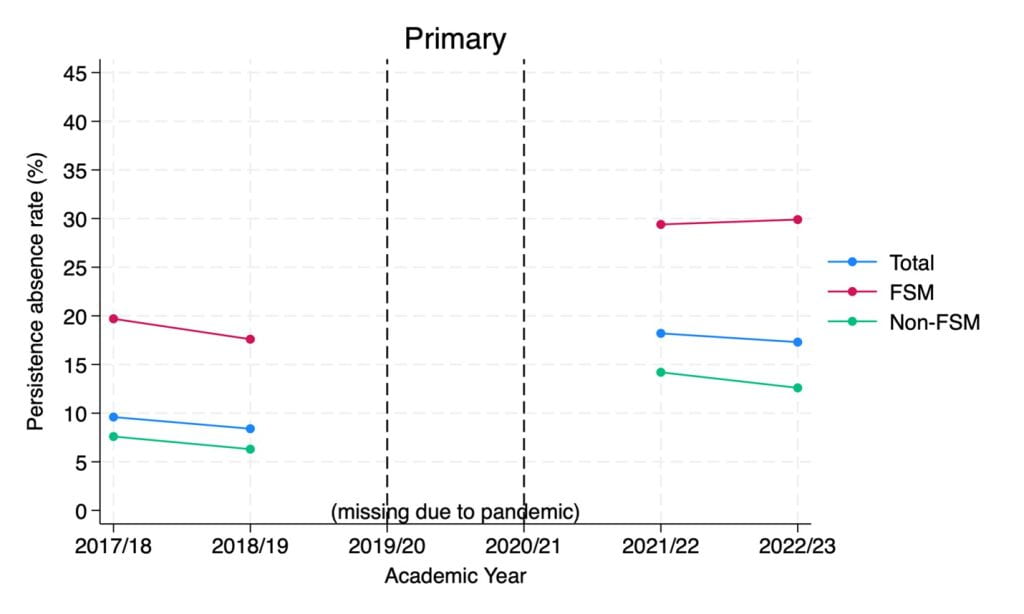
Figure 1: Rates of persistent absence among primary school pupils overall, and by Free School Meals (FSM) eligibility.
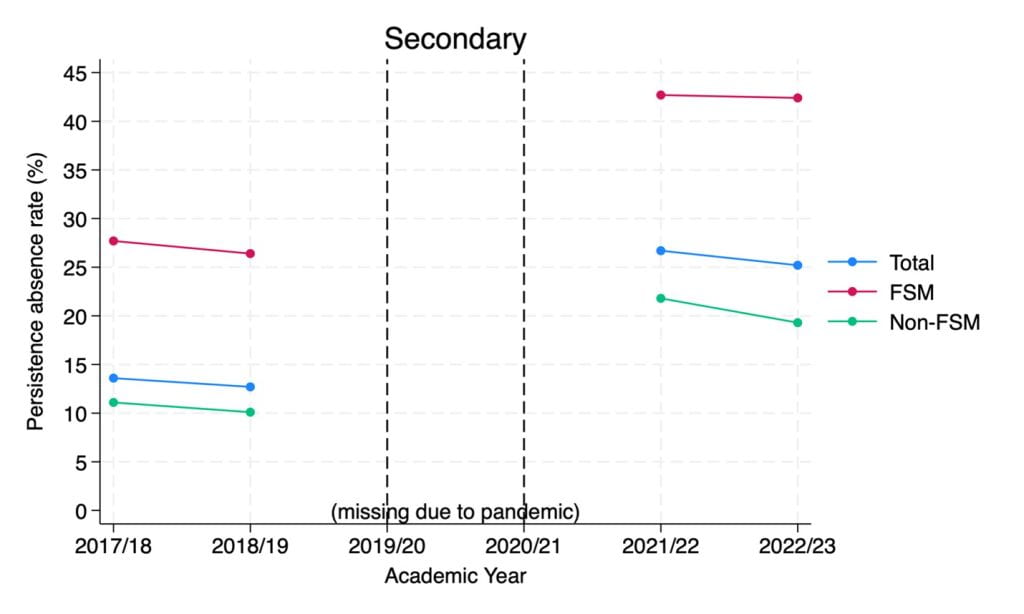
Figure 2: Rates of persistent absence among secondary school pupils overall, and by Free School Meals (FSM) eligibility. Source: https://explore-education-statistics.service.gov.uk/data-tables/permalink/49cbd2eb-ba9b-4fe4-ea17-08dc0dc60f26
A similar pattern emerges when looking at rates of persistent absenteeism across year groups within primary and secondary settings, as illustrated by Figure 2. While all year groups have seen a large increase in rates of persistent absenteeism from 2018/19 to 2021/22, the increases have again been consistent across year groups: for example, in primary year 1 or below, persistent absenteeism rates have increased by 10ppts while for year 6 they have increased by 10.9ppts. At secondary school, there have been slightly larger increases relative to primary schools, but within the former, persistent absenteeism rates for young people in year 8 have increased by 13.5ppts while for year 11 they have increased by 15.2ppts.
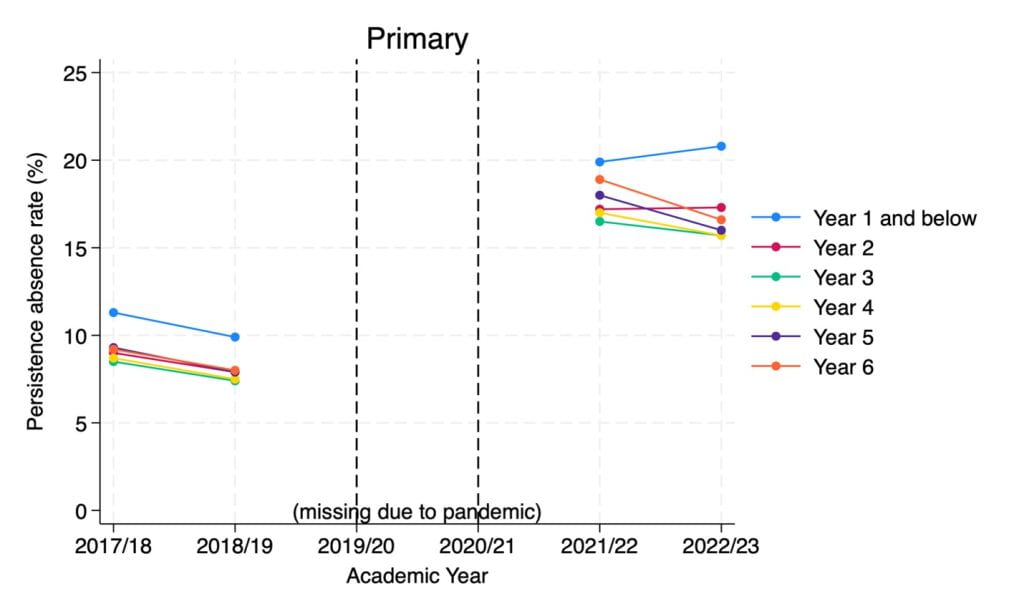
Figure 3: Rates of persistent absence by primary school year group.
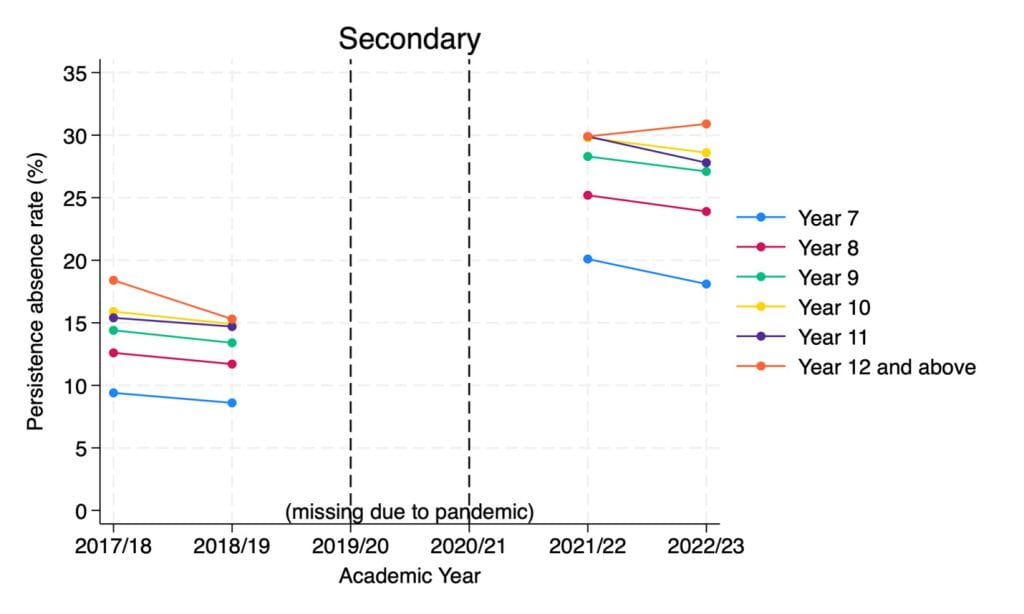
Figure 4: Rates of persistent absence by secondary school year group.
What do we know about the drivers of this phenomenon?
CEPEO’s previous analysis of persistent absence using data from the COVID Social Mobility & Opportunities (COSMO) study, a representative study following a cohort of young people as they complete their education and led by CEPEO along with the UCL Centre for Longitudinal Studies and Sutton Trust, highlighted some of the key factors that predict pupils’ persistent absence. As shown in Figure 3, when we compare pupils from similar backgrounds, with similar levels of prior attainment and demographic characteristics, pupils are more likely to be persistently absent if their families are experiencing a difficult financial situation (as indicated in our analysis by recent use of food banks), if they have special educational needs, and if they have experienced mental health issues.
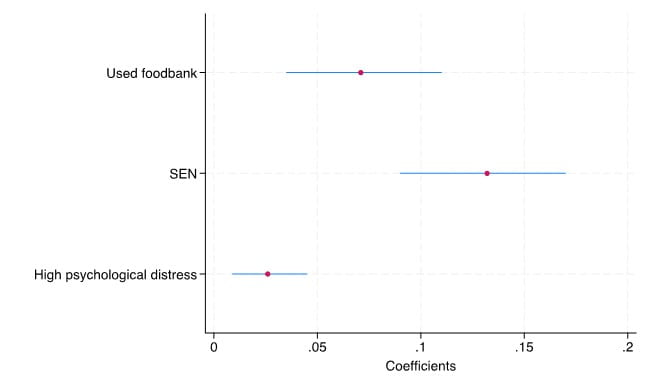
Figure 5: Change in probability of pupils living in households that used a food bank, pupils with SEN status and pupils with high psychological distress being persistently absent from school, relative to their otherwise similar peers. Notes. N = 4,387. Reporting change in probability (marginal effects) while also adjusting for gender, ethnicity, parental education, parental occupational status, and Key Stage 2 prior attainment; SEN = Special Educational Needs.
Cost-of-living crisis and disadvantage
Our findings from COSMO indicate that young people in families who have recently made use of a food bank are 7 percentage points more likely to be persistently absent from school than otherwise similar pupils. It seems likely that the challenges of family management in such circumstances are contributing to the higher rates seen among this group.
Focus groups with parents from across the country, run as part of research by Public First to delve into some of the motivations underlying the increased rates of absence we have described, highlight factors linked to these. They conclude that “the cost-of-living crisis is driving more families into poverty, and this is an underlying driver of poor attendance in families from lower and no-income groups”, noting that issues such as transport costs are a straightforward reason why young people in families struggling to afford the basics are more likely not to be at school every day.
However, note that our description of trends in persistent absenteeism in Figure 1 suggests similar increases in persistent absenteeism among both those eligible and not eligible for free school meals. Our previous research has shown that financial distress is no longer restricted to families eligible for free school meals, but this also indicates the likely presence of alternative drivers of this trend among those in more advantaged groups.
Special Educational Needs provision
Having a special educational need (SEN) was the strongest predictor of persistent absence among the young people in COSMO: those with such a need were 13 percentage points more likely to be persistently absent. Polling by YouGov for the recent report on absenteeism by the Centre for Social Justice (CSJ) noted that 4% of parents say their child had missed school due to having a special educational need that was not being met by the school. A further 73% of parents say their child missed school on medical grounds. It seems likely that concerns about SEN provision in schools, perhaps compounded by a need to attend medical appointments associated with some kinds of special educational need, are important in explaining part of the trend in persistent absenteeism — which may also compound educational disadvantages associated with the SEN itself.
Mental health crisis
The issue of young people’s mental health also appears to predict persistent absence from school. In COSMO, our analysis found that those experiencing high levels of psychological distress were 2.6 percentage points more likely to be persistently absent from school, compared to similar young people who did not report high levels of psychological distress. Similar findings around the looming mental health crisis were noted in Public First’s work, summarised in their conclusion that “the mental health crisis in young people is a huge, compounding issue around attendance”.
Similarly, the CSJ found that 8% of parents reported that their child has missed school due to diagnosed mental health issues, while the same percentage reported their child missing school due to anxiety. Adding to the complexity of the picture, their analysis notes that low-income households and those not in work were significantly more likely (12%) to say their child had missed school due to a mental health reason. This further adds to the surprising lack of difference in increase in persistent absence between those eligible for free school meals and those who are not.
Attitudes of parents, young people, and the social contract
Beyond the tangible potential drivers highlighted in our data analysis with actionable policy implications, albeit very challenging ones, research carried out by both Public First and CSJ foreground the importance of broader attitudinal shifts: an underlying theme of several of Public First’s conclusions is the existence of substantial changes in parental attitudes towards the importance of attendance at school, in particular since the COVID-19 disruption to in-person schooling. Similarly, the report by the CSJ focuses on the role of parental attitudes, highlighting that while 88% of parents agree that every single day of school matters and it is vital children attend as much school as possible, 8% disagree and 28% agree that the pandemic has shown it is not essential for children to attend school every day.
That the increase in persistent absence is slightly larger among secondary school pupils could potentially indicate that this is part of the explanation. Secondary school pupils not attending school are less likely to have child supervision implications than would be the case for a primary school pupil, which may make this dynamic more likely to arise. However, this difference in relative increases between primary and secondary pupils is actually relatively small, and this link rather speculative. Perhaps even more surprising, if this were a major driver of the jump in persistent absenteeism, is the consistency in increases across year groups within settings. To the extent that new parents enter the school system each year, we might expect to see larger increases among older year groups in primary schools (who were impacted by the pandemic) relative to younger year groups if attitudes had been so fundamentally impacted.
Some of the manifestations of this change highlighted by Public First’s focus groups include shifting attitudes to term-time holidays, such that they are much more widely seen as socially acceptable across all socioeconomic groups. Similarly, the recent CSJ report suggests that 13% of parents gave holidays as a reason for why children missed school.
Mending this damaged social contract and reinforcing the messaging that “every day matters” when it comes to attending school will be an important part of the policy response.
To hear more and put your questions to the panel, book your place for our online event ‘Pupil absence: Questions for policy, for research and in practice’ on 22 January 2024, 17:30-19:00.
 Close
Close



